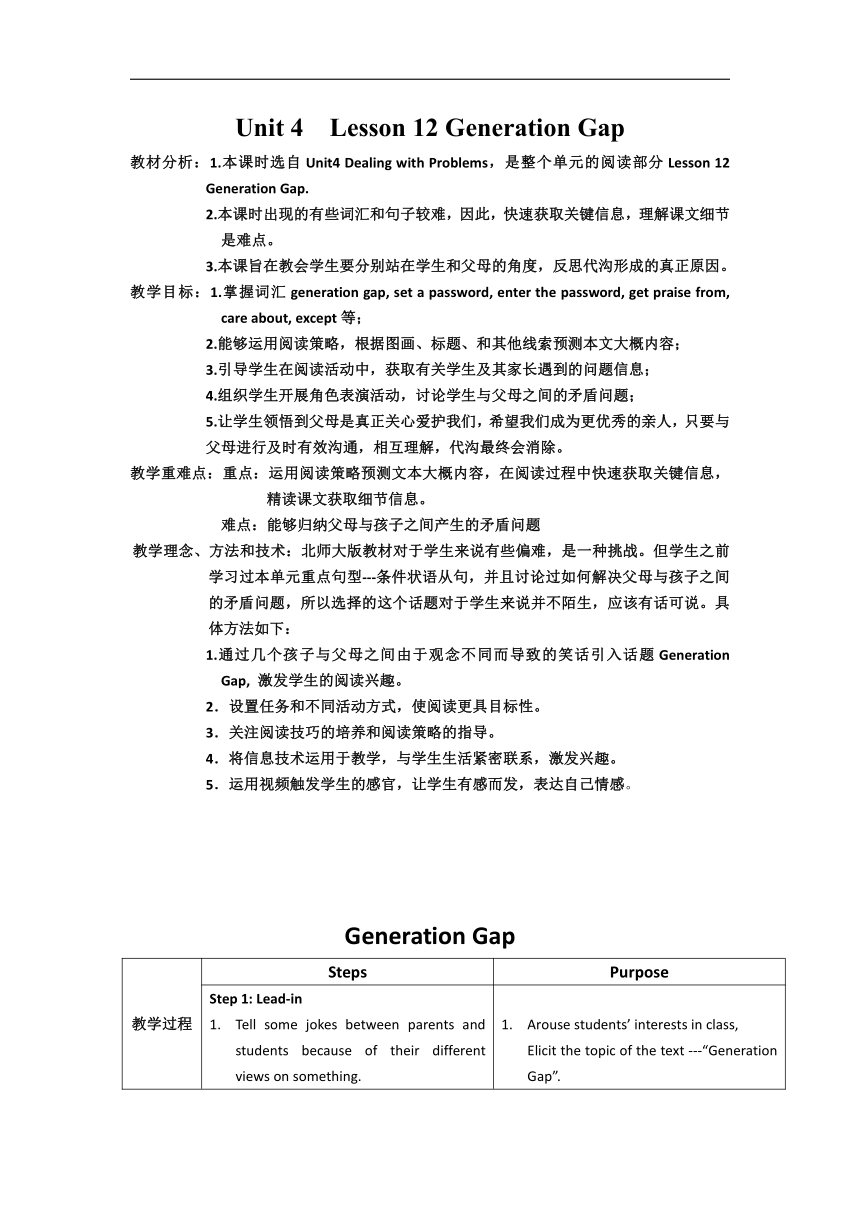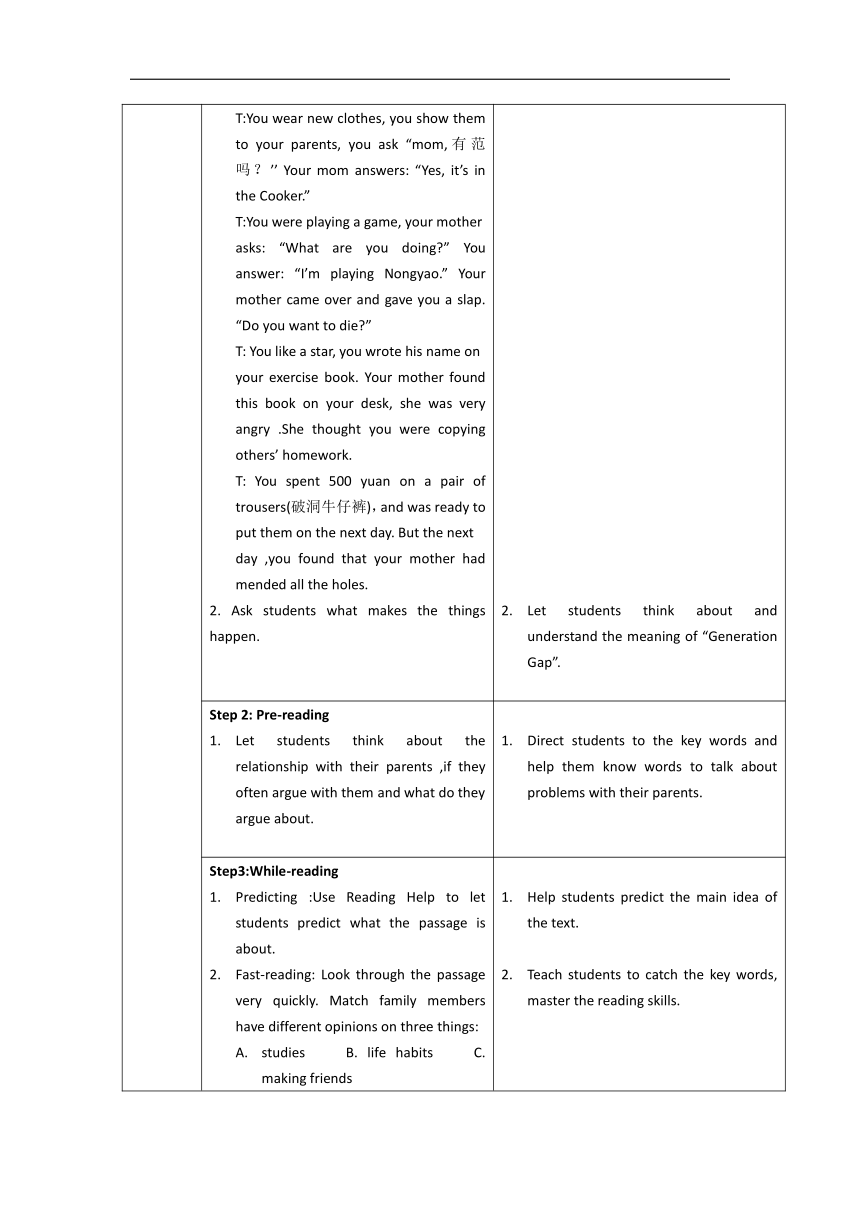北师大版英语八年级下册 Unit 4 Dealing with Problems Lesson 12 Generation Gap 教案(表格式)
文档属性
| 名称 | 北师大版英语八年级下册 Unit 4 Dealing with Problems Lesson 12 Generation Gap 教案(表格式) |  | |
| 格式 | docx | ||
| 文件大小 | 24.6KB | ||
| 资源类型 | 教案 | ||
| 版本资源 | 北师大版 | ||
| 科目 | 英语 | ||
| 更新时间 | 2022-06-16 15:55:08 | ||
图片预览


文档简介
Unit 4 Lesson 12 Generation Gap
教材分析:1.本课时选自Unit4 Dealing with Problems,是整个单元的阅读部分Lesson 12 Generation Gap.
2.本课时出现的有些词汇和句子较难,因此,快速获取关键信息,理解课文细节是难点。
3.本课旨在教会学生要分别站在学生和父母的角度,反思代沟形成的真正原因。
教学目标:1.掌握词汇generation gap, set a password, enter the password, get praise from, care about, except等;
2.能够运用阅读策略,根据图画、标题、和其他线索预测本文大概内容;
3.引导学生在阅读活动中,获取有关学生及其家长遇到的问题信息;
4.组织学生开展角色表演活动,讨论学生与父母之间的矛盾问题;
5.让学生领悟到父母是真正关心爱护我们,希望我们成为更优秀的亲人,只要与父母进行及时有效沟通,相互理解,代沟最终会消除。
教学重难点:重点:运用阅读策略预测文本大概内容,在阅读过程中快速获取关键信息,精读课文获取细节信息。
难点:能够归纳父母与孩子之间产生的矛盾问题
教学理念、方法和技术:北师大版教材对于学生来说有些偏难,是一种挑战。但学生之前学习过本单元重点句型---条件状语从句,并且讨论过如何解决父母与孩子之间的矛盾问题,所以选择的这个话题对于学生来说并不陌生,应该有话可说。具体方法如下:
1.通过几个孩子与父母之间由于观念不同而导致的笑话引入话题Generation Gap, 激发学生的阅读兴趣。
2.设置任务和不同活动方式,使阅读更具目标性。
3.关注阅读技巧的培养和阅读策略的指导。
4.将信息技术运用于教学,与学生生活紧密联系,激发兴趣。
5.运用视频触发学生的感官,让学生有感而发,表达自己情感。
Generation Gap
教学过程 Steps Purpose
Step 1: Lead-in Tell some jokes between parents and students because of their different views on something. T:You wear new clothes, you show them to your parents, you ask “mom,有范吗?’’ Your mom answers: “Yes, it’s in the Cooker.” T:You were playing a game, your mother asks: “What are you doing ” You answer: “I’m playing Nongyao.” Your mother came over and gave you a slap. “Do you want to die ” T: You like a star, you wrote his name on your exercise book. Your mother found this book on your desk, she was very angry .She thought you were copying others’ homework. T: You spent 500 yuan on a pair of trousers(破洞牛仔裤),and was ready to put them on the next day. But the next day ,you found that your mother had mended all the holes. 2. Ask students what makes the things happen. Arouse students’ interests in class, Elicit the topic of the text ---“Generation Gap”. Let students think about and understand the meaning of “Generation Gap”.
Step 2: Pre-reading Let students think about the relationship with their parents ,if they often argue with them and what do they argue about. Direct students to the key words and help them know words to talk about problems with their parents.
Step3:While-reading Predicting :Use Reading Help to let students predict what the passage is about. Fast-reading: Look through the passage very quickly. Match family members have different opinions on three things: studies B. life habits C. making friends Careful-reading: Read the whole passage carefully, and answer “What do the students and parents argue about ” Intensive-reading: Read the first family and answer the questions. “Do you think Andy is a good student at school How do you know that ” “What does Andy need ” “What do you think Susan wants Andy to spend time on ” Read the second family and check the sentences. Jessica thinks her mother controls her a lot.( ) Karen is worried that Jessica’s friends don’t like her.( ) Read the third family and fill in the blanks. Edward can have friends __________to his house any time . He never argues with his father ______ when his father makes him ____________.But he thinks he can find things __________if they are _________. George lets Edward bring friends home whenever he wants. He is an__________ father. But he complains that Edward’s room is _________sometimes. He says Edward never _____________and hates _____________. Ask students “What do the students in the text really need ” and “What do their parents want their children to do ” Role-play time: Role-play a student and a parent from the reading. T:“Choose one student and parent. Role-play the student and parent. Try to communicate with each other”. Help students predict the main idea of the text. Teach students to catch the key words, master the reading skills. Help students summarize problems in the text. Check out if students are clear about details of the text in each family. Understand the formation of contradictions between parents and children. 5.Role-play the characters in the passage, let them say their problems.
Step4:After-reading Watch a video about parents care about their child. T:Every family has its problems. Every family has different environment, circumstances. Every child has different personality , interests, ideals. Every parent has different requirements, expectations, ways of raising child. But parents’ love for their child is the same. Speak out the true feelings. T: Students say something to their parents by sending a WeChat. Students receive a message from a mother. T: “When your parents are strict with you, it doesn’t mean they don’t understand you, they only want you to be a better person…” 1. The video is so moving that it educates students to understand the love from their parents. 2. Let students express their true feelings to their parents. 3. Students know their parents’ innermost thoughts and feelings. 4.Let students know their parents are the persons who really care about them.
Step 5: Homework Write a letter or send a message to your parents to speak out your feelings. Homework is designed to help students to solve their own problems by communicating with their parents.
板书设计
Unit 4 Lesson 12 Generation Gap
text your friends set a password enter the password get praise from except Andy needs free time to relax. Susan wants Andy to spend more time on studies.
Jessica needs freedom. Karen is worried that Jessica makes bad friends.
Edward needs to be relax. George wants Edward to get into good habits.
教学反思:
本节课我通过创设有趣情景,以生动有趣的父母与孩子之间由于理解差异造成的笑话,将学生带入一个轻松的学习氛围中,以激发学生学习兴趣。设置活泼语言交际情景,给学生提供充分口语表达机会。在学习过程中,我设法将教材内容变成活泼的语言交际情境,让学生兴致勃勃地参与语言实践。师生双方通过在情感上的交流与沟通,激发了学生积极学习热情和创造意识。
本节课的不足之处在于:1.学生在表演父母与孩子之间对话时,没有最终达成和解。2.由于想让更多的学生有机会回答问题,在等待学生举手时浪费了些时间,导致节奏有些慢。
教材分析:1.本课时选自Unit4 Dealing with Problems,是整个单元的阅读部分Lesson 12 Generation Gap.
2.本课时出现的有些词汇和句子较难,因此,快速获取关键信息,理解课文细节是难点。
3.本课旨在教会学生要分别站在学生和父母的角度,反思代沟形成的真正原因。
教学目标:1.掌握词汇generation gap, set a password, enter the password, get praise from, care about, except等;
2.能够运用阅读策略,根据图画、标题、和其他线索预测本文大概内容;
3.引导学生在阅读活动中,获取有关学生及其家长遇到的问题信息;
4.组织学生开展角色表演活动,讨论学生与父母之间的矛盾问题;
5.让学生领悟到父母是真正关心爱护我们,希望我们成为更优秀的亲人,只要与父母进行及时有效沟通,相互理解,代沟最终会消除。
教学重难点:重点:运用阅读策略预测文本大概内容,在阅读过程中快速获取关键信息,精读课文获取细节信息。
难点:能够归纳父母与孩子之间产生的矛盾问题
教学理念、方法和技术:北师大版教材对于学生来说有些偏难,是一种挑战。但学生之前学习过本单元重点句型---条件状语从句,并且讨论过如何解决父母与孩子之间的矛盾问题,所以选择的这个话题对于学生来说并不陌生,应该有话可说。具体方法如下:
1.通过几个孩子与父母之间由于观念不同而导致的笑话引入话题Generation Gap, 激发学生的阅读兴趣。
2.设置任务和不同活动方式,使阅读更具目标性。
3.关注阅读技巧的培养和阅读策略的指导。
4.将信息技术运用于教学,与学生生活紧密联系,激发兴趣。
5.运用视频触发学生的感官,让学生有感而发,表达自己情感。
Generation Gap
教学过程 Steps Purpose
Step 1: Lead-in Tell some jokes between parents and students because of their different views on something. T:You wear new clothes, you show them to your parents, you ask “mom,有范吗?’’ Your mom answers: “Yes, it’s in the Cooker.” T:You were playing a game, your mother asks: “What are you doing ” You answer: “I’m playing Nongyao.” Your mother came over and gave you a slap. “Do you want to die ” T: You like a star, you wrote his name on your exercise book. Your mother found this book on your desk, she was very angry .She thought you were copying others’ homework. T: You spent 500 yuan on a pair of trousers(破洞牛仔裤),and was ready to put them on the next day. But the next day ,you found that your mother had mended all the holes. 2. Ask students what makes the things happen. Arouse students’ interests in class, Elicit the topic of the text ---“Generation Gap”. Let students think about and understand the meaning of “Generation Gap”.
Step 2: Pre-reading Let students think about the relationship with their parents ,if they often argue with them and what do they argue about. Direct students to the key words and help them know words to talk about problems with their parents.
Step3:While-reading Predicting :Use Reading Help to let students predict what the passage is about. Fast-reading: Look through the passage very quickly. Match family members have different opinions on three things: studies B. life habits C. making friends Careful-reading: Read the whole passage carefully, and answer “What do the students and parents argue about ” Intensive-reading: Read the first family and answer the questions. “Do you think Andy is a good student at school How do you know that ” “What does Andy need ” “What do you think Susan wants Andy to spend time on ” Read the second family and check the sentences. Jessica thinks her mother controls her a lot.( ) Karen is worried that Jessica’s friends don’t like her.( ) Read the third family and fill in the blanks. Edward can have friends __________to his house any time . He never argues with his father ______ when his father makes him ____________.But he thinks he can find things __________if they are _________. George lets Edward bring friends home whenever he wants. He is an__________ father. But he complains that Edward’s room is _________sometimes. He says Edward never _____________and hates _____________. Ask students “What do the students in the text really need ” and “What do their parents want their children to do ” Role-play time: Role-play a student and a parent from the reading. T:“Choose one student and parent. Role-play the student and parent. Try to communicate with each other”. Help students predict the main idea of the text. Teach students to catch the key words, master the reading skills. Help students summarize problems in the text. Check out if students are clear about details of the text in each family. Understand the formation of contradictions between parents and children. 5.Role-play the characters in the passage, let them say their problems.
Step4:After-reading Watch a video about parents care about their child. T:Every family has its problems. Every family has different environment, circumstances. Every child has different personality , interests, ideals. Every parent has different requirements, expectations, ways of raising child. But parents’ love for their child is the same. Speak out the true feelings. T: Students say something to their parents by sending a WeChat. Students receive a message from a mother. T: “When your parents are strict with you, it doesn’t mean they don’t understand you, they only want you to be a better person…” 1. The video is so moving that it educates students to understand the love from their parents. 2. Let students express their true feelings to their parents. 3. Students know their parents’ innermost thoughts and feelings. 4.Let students know their parents are the persons who really care about them.
Step 5: Homework Write a letter or send a message to your parents to speak out your feelings. Homework is designed to help students to solve their own problems by communicating with their parents.
板书设计
Unit 4 Lesson 12 Generation Gap
text your friends set a password enter the password get praise from except Andy needs free time to relax. Susan wants Andy to spend more time on studies.
Jessica needs freedom. Karen is worried that Jessica makes bad friends.
Edward needs to be relax. George wants Edward to get into good habits.
教学反思:
本节课我通过创设有趣情景,以生动有趣的父母与孩子之间由于理解差异造成的笑话,将学生带入一个轻松的学习氛围中,以激发学生学习兴趣。设置活泼语言交际情景,给学生提供充分口语表达机会。在学习过程中,我设法将教材内容变成活泼的语言交际情境,让学生兴致勃勃地参与语言实践。师生双方通过在情感上的交流与沟通,激发了学生积极学习热情和创造意识。
本节课的不足之处在于:1.学生在表演父母与孩子之间对话时,没有最终达成和解。2.由于想让更多的学生有机会回答问题,在等待学生举手时浪费了些时间,导致节奏有些慢。
同课章节目录
- Unit 1 Technology and the Future
- Lesson 1 Schools of the Future
- Lesson 2 Online Life
- Lesson 3 Tomorrow's Jobs
- Communication Workshop
- Unit 2 Communication
- Lesson 4 Animal Talk
- Lesson 5 Meeting People
- Lesson 6 The Texting Generation
- Communication Workshop
- Unit 3 Festivals and Holidays
- Lesson 7 Chinese New Year
- Lesson 8 A Picnic
- Lesson 9 Thanksgiving
- Communication Workshop
- Unit 4 Dealing with Problems
- Lesson 10 Problem Page
- Lesson 11 Online Time
- Lesson 12 Generation Gap
- Communication Workshop
- Unit 5 Memories
- Lesson 13 A Daughter's Letter
- Lesson 14 Grandpa's Memories
- Lesson 15 Life in the 1950s
- Communication Workshop
- Unit 6 Detectives
- Lesson 16 A Detective Story (I)
- Lesson 17 A Detective Story (II)
- Lesson 18 The Mystery Writer
- Communication Workshop
